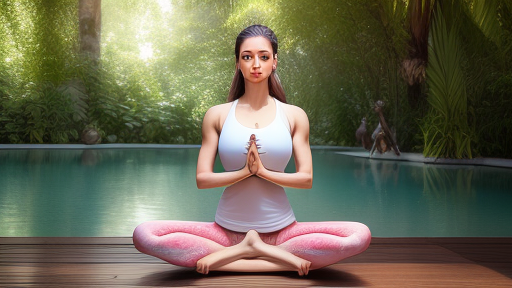Handstand for Mental Health: Reducing Stress and Anxiety
Handstand for Mental Health: Reducing Stress and Anxiety
Introduction
Hey there! Are you feeling stressed out or overwhelmed by the demands of everyday life? Well, I’ve got some exciting news for you. Did you know that handstands can do wonders for your mental health? It’s true! In this article, we’ll explore how incorporating handstands into your routine can help reduce stress and anxiety, and bring a sense of calm and clarity to your mind. So, let’s dive in and discover the incredible benefits that handstands can offer for your mental well-being.
Section 1: The Mind-Body Connection
You may be wondering, “How can something as physical as a handstand have an impact on my mental health?” Well, let me tell you, the mind and body are intricately connected. When you engage in physical activities like handstands, it has a profound effect on your mental state. The rush of blood to the brain, the release of endorphins, and the focus required during a handstand all contribute to a sense of calm and mental clarity.
Section 2: Handstands as a Stress Reliever
Life can get pretty hectic at times, and stress seems to be an unavoidable part of the modern world. But fear not! Handstands can be your secret weapon against stress. When you’re inverted in a handstand, the world looks different. It’s a unique perspective that allows you to momentarily escape the stressors of daily life. The concentration required to balance and hold the handstand also helps shift your focus away from your worries, providing a much-needed mental break.
Section 3: Handstands and Anxiety Reduction
Anxiety can be a challenging companion, but handstands can help you tame it. The controlled breathing and mindful presence necessary for handstands create a meditative state that can alleviate anxiety. As you find balance and stability in the handstand, it’s as if you’re finding balance within yourself, bringing a sense of peace and calm to your mind. Plus, the physical exertion of a handstand releases tension and promotes relaxation, helping to reduce anxiety levels.
Section 4: Building Confidence and Empowerment
One of the beautiful things about handstands is the sense of accomplishment they bring. As you progress in your handstand practice and master new skills, you’ll experience a boost in self-confidence. Overcoming the fear of falling and defying gravity in a handstand cultivates a deep sense of empowerment. This newfound confidence extends beyond the handstand and can positively impact other areas of your life, allowing you to face challenges with resilience and belief in yourself.
Section 5: Mindful Presence and Focus
In our fast-paced world, it’s easy to get caught up in the constant chatter of our minds. Handstands offer a way to quiet the noise and cultivate mindful presence. When you’re upside down in a handstand, there’s no room for distractions. You’re fully engaged in the present moment, focusing on your breath, balance, and alignment. This intense focus trains your mind to let go of worries and be fully present, fostering a sense of mental clarity and peace.
Section 6: Incorporating Handstands into Your Routine
Now that you’re excited about the mental health benefits of handstands, you may be wondering how to incorporate them into your routine. Here are some tips to get you started:
1. Start with Wall-Assisted Handstands
If you’re new to handstands, begin by practicing against a wall. This provides support and helps you build confidence. Start by facing the wall, place your hands shoulder-width apart, kick up gently, and allow your feet to rest against the wall. As you become more comfortable, gradually reduce your reliance on the wall for support.
2. Find a Spotter
Having a spotter can be incredibly helpful, especially when you’re working on more advanced handstand variations. A spotter can provide guidance, support, and ensure your safety during the practice. They can assist with balance and help prevent falls or injuries. Remember, it’s always better to have someone there to support you, both physically and mentally.
3. Practice Mindful Breathing
Breathing plays a vital role in your handstand practice and its impact on your mental health. Focus on slow, deep breaths as you enter and hold the handstand position. Pay attention to the sensation of the breath filling your lungs and the exhale releasing any tension or stress. Mindful breathing not only enhances your physical stability but also calms the mind and promotes relaxation.
4. Progress Gradually
Remember, Rome wasn’t built in a day, and the same goes for your handstand journey. Take it step by step and progress at your own pace. Start with shorter holds against the wall and gradually increase the duration as your strength and confidence grow. Explore different variations, such as straddle handstands or handstand push-ups, but always prioritize safety and listen to your body.
5. Embrace the Journey
Lastly, remember that handstands are not just about achieving a specific pose. It’s about the journey itself?the process of self-discovery, growth, and self-care. Embrace the ups and downs, the wobbles, and the falls. Celebrate each small victory along the way, and don’t forget to have fun! Handstands are not just a physical practice; they are an opportunity to connect with yourself on a deeper level.
Conclusion
Congratulations! You now have a deeper understanding of how handstands can positively impact your mental health. By incorporating handstands into your routine, you can reduce stress, alleviate anxiety, improve focus, and boost self-confidence. Remember to approach your handstand practice with patience, mindfulness, and a sense of adventure.
So, what are you waiting for? Step onto your mat, kick up your legs, and embrace the transformative power of handstands. Let the joy, empowerment, and mental clarity wash over you as you explore the world of inversions. Your mind and body will thank you for it.
Note: The information provided in this article is for educational purposes only. Please consult with a healthcare professional or certified trainer before attempting any new exercise or fitness regimen.
You may like this video!
